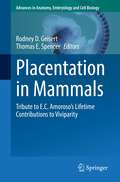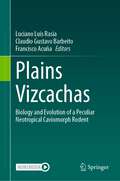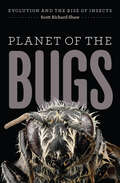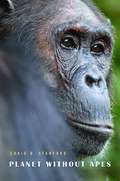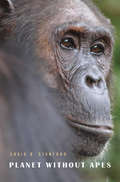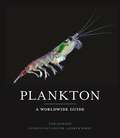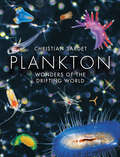- Table View
- List View
Pitfalls in Veterinary Surgery
by Geraldine B. HuntPitfalls in Veterinary Surgery offers a candid examination of real-life mistakes and mishaps encountered while operating on veterinary patients. Describes a range of mistakes and mishaps encountered by a veterinary surgeon with 30+ years of experience Provides an honest examination of the reality of operating on pets Offers the opportunity to learn from an experienced surgeon’s mistakes Discusses mistakes in a wide range of situations, ranging from commonplace to unusual Presents a realistic view of veterinary surgery, including how to live with mistakes
Pitfalls in Veterinary Surgery
by Geraldine B. HuntPitfalls in Veterinary Surgery offers a candid examination of real-life mistakes and mishaps encountered while operating on veterinary patients. Describes a range of mistakes and mishaps encountered by a veterinary surgeon with 30+ years of experience Provides an honest examination of the reality of operating on pets Offers the opportunity to learn from an experienced surgeon’s mistakes Discusses mistakes in a wide range of situations, ranging from commonplace to unusual Presents a realistic view of veterinary surgery, including how to live with mistakes
Pituitary Disease (Endocrine Updates #18)
by Michael C. Sheppard and Paul M. StewartPituitary Disease brings together an international panel of experts who summarize the most recent and exciting advances in the diagnosis and treatment of pituitary disease. Coverage includes pathogenesis and pathology of pituitary tumors; clinical scenarios underpinning each type of pituitary tumor as well as their diagnosis and treatment. It is a useful resource for clinicians, students or researchers with an interest in the pituitary and its disorders.
The Pituitary Gland (Clinical Surveys in Endocrinology #1)
by C. R. KannanThe past two decades have witnessed an unprecedented growth in the field ofneuroendocrinology. The conjoint research contributions by clinicians and basic scientists have promulgated revolutionary concepts at a breakneck speed. This first volume in Clinical Surveys in Endocrinology, The Pituitary Gland, has been written with but one purpose in mind: to integrate the current knowledge in this dynamic field with the existing body of information already available to the clinician. The chapters in this book attempt to portray current research information seen through the eyes of a clinician. The contributions of pioneers in each field have been placed in a perspective relevant to the practicing endocrinologist. The selection of the almost 1500 references from a bewil of literature has been inftuenced by the degree to which these dering body articles-original as weil as review papers-contributed to the growth of pi tuitary endocrinology. Despite the most scrutinizing attempts, it is inevitable and regrettable that works of importance must be excluded due to the practical limitations of any comprehensive work. Nevertheless, to the researcher these references are complete enough to serve as a significant resource. To the reader who wishes to gain an indepth clinical perspective of pituitary disor ders, this work is written precisely from that vantage point. The single authorship of this work notwithstanding, several friends have been instrumental in the completion of this work. I deeply appreciate the incessant zeal and excellent assistance of Ms.
Placentation in Mammals: Tribute to E.C. Amoroso’s Lifetime Contributions to Viviparity (Advances in Anatomy, Embryology and Cell Biology #234)
by Rodney D. Geisert Thomas E. SpencerThe present volume of the book series Advances in Anatomy, Embryology and Cell Biology brings together current reviews from leading experts to address the diversity of placentation by which species establish and maintain pregnancy. Development of viviparity and placentation in rodents, dogs, pigs, cattle, horses, marsupials, primates and elephants are discussed. The development of viviparity in mammals, including some invertebrate species, required the adaptation of the placenta to serve as a functional conduit for interplay between the semiallograftic fetus with the maternal uterus. Although the ‘placenta’ protects the fetus from maternal immune rejection and provides oxygen and nutrient flow to support it to term across all the species, structural differentiation of this fetal-maternal interface can vary from simple to very complex. E.C. Amoroso contributed greatly to our early understanding and knowledge of placentation across a great variety of species. His work on placentation provides numerous illustrations and histological sections which are used for teaching and stimulating research today. With this book, we want to pay tribute to his lifetime contributions to the field by reviewing our current understanding of the development of viviparity and placentation in different species. The book is written for researchers, physicians and medical students working in the field of reproductive science or with an interest in placentation and viviparity.
Plains Vizcachas: Biology and Evolution of a Peculiar Neotropical Caviomorph Rodent
by Luciano Luis Rasia Claudio Gustavo Barbeito Francisco AcuñaThe plains vizcacha (Lagostomus maximus) is a remarkable rodent of the Neotropic given several peculiar aspects of its biology, some of them quite unique among rodents or even among mammals. This book gathers specialists studying plains vizcachas from very different approaches, including paleontology, systematics, morphology, physiology, development and conservation. It is divided in two Parts, 1) Evolutionary History, and 2) Morphology, Development and Physiology. It will surely be a required reading for any researcher working with caviomorph rodents, mastozoology of the Neotropics or internal anatomy and physiology of mammals.
Plan of a Roman Bath House (UEB uncontracted)
by RnibThe image shows a plan of a typical Roman Bath House. There is a locator dot shown, which will be at the top left when the image is the correct way up. The entrance to the Bath House (aditus) is in the bottom right of the page. It is a small area with a door to the changing room (apodyterium) on the left. To the top right of the changing room is a door to a small storeroom. This is where the aromatic oils used in the bath house would be kept. To the top left of the changing room is a door to a small lobby area (vestibule) which is an entrance way into the baths from the changing rooms. Left from here is the cool room (frigidarium) with a cold pool. Up from the cool room is the warm room (tepidarium). There is a tepid pool here. To the right of this is a hot but normally dry room (laconicum). Up from the warm room is another hot room (caldarium), this time with a hot pool. This room usually has a cold fountain (labrum) as well. The water from the fountain is used to splash on the face for refreshment. Right from here is another hot room (alveus) with really hot baths. Not all bath houses have this type of room. Right from here is the furnace room (Praefurnium). This is where the fires to heat the rooms and baths are. There is a door into the room from the outside in the top left of the room. Notice that the nearer a room is to the furnace room the hotter it and its water is. Hot air is circulated under the floor and into wall cavities via channels (hypocausts), so the nearer a room is to the furnace the hotter this air will be. Only the three hot rooms have hot air wall spaces.
Planen und Handeln: Neurowissenschaftliche, psychologische, medizinische und gesellschaftsrelevante Aspekte
by Wolfgang Walkowiak Julia Maria Erber-SchroppZiel dieses Bandes ist es, an konkretem Verhalten, nämlich der Planung, Entscheidung und Ausführung von Handlungen, zu demonstrieren, welche aktuellen Kenntnisse bereits auf den verschiedenen Untersuchungsebenen vorliegen und welche Auswirkungen diese Kenntnisse auf verschiedene Bereiche der menschlichen Gesellschaft haben. Das Konzept der Handlungsselektion (Action Selection) ist traditionell Thema einer Reihe verschiedener Forschungsansätze in der Psychologie und der Verhaltensforschung. In jüngerer Zeit haben sich auch die Neurobiologie, die Computer-Neurowissenschaften, die KI-Forschung und Robotik zunehmend dieser Problematik angenommen. Handlungsplanung, -ausführung und Monitoring eignen sich als Thema für eine Standortbestimmung in besonderer Weise, da experimentelle Daten aus der Psychologie, der Neurobiologie und der Modellierung zur Verfügung stehen.
Planet Earth II
by Stephen Moss10 years on from the first, groundbreaking, Planet Earth, we use the most incredible advances in technology and scientific discovery to bring you the most exciting and immersive picture of our world's wildlife yet. With over 250 breathtaking photographs and stills from the BBC Natural History Unit's spectacular footage, this is an extraordinary new look at the complex life of some of the most amazing places on Planet Earth. Each chapter reveals an environment – some never-before-seen, some astonishingly familiar – defined by a unique set of rules required for survival. From the most desolate desert to the depths of the jungle, from blistering heat and freezing cold to perpetual darkness and deadly UV, discover how a whole host of creatures have adapted to life in the most extreme conditions. And how they compete with one another to become the largest, the fastest, the most poisonous, or most devious - all in a bid to survive. Planet Earth II includes the first in-depth look at the urban environment, and the surprising range of behaviours occurring right under our noses, as well as some previously untouched island worlds. Filmed with remarkable 5k and infra-red technology, these are the challenges, the confrontations, and the triumphs of some of the most extraordinary creatures in the natural world, told from their perspective. This is our planet, as you have never seen it before.
Planet Earth III: Accompanies the Landmark Series Narrated by David Attenborough
by Matt Brandon Michael Gunton Jonny KeelingThe official tie-in to the third instalment in the legendary Planet Earth franchiseFew places on Earth remain untouched by humans, creating challenges for the wildlife we share it with. We have entered a new age, and we must look at the splendour of the natural world through a different lens.From the depths of our oceans, to scorching deserts and the most remote jungles, Planet Earth III features spectacular places and surprising animal behaviours from all corners of our world. And for the first time, a human element is introduced to each landscape, highlighting how, in the age of the Anthropocene, today's planet has been forever changed by humanity and that wildlife now faces new challenges in our crowded, modern world.Featuring over 250 beautiful full-colour photographs, Planet Earth III reveals the wonders and trials of life on an increasingly fragile planet, bringing you closer than ever before to our world’s most intriguing species, unseen landscapes and natural phenomena.
Planet Earth III (BBC Earth)
by Leisa Stewart-SharpeThis is our Planet Earth. From the highest peaks to the mysterious seafloor, almost every habitat has been impacted by humans.In this beautifully illustrated guide, you'll see our interconnected natural world as never before.You'll meet venomous snakes that are welcomed into people's homes. Tiny treehoppers that form an alliance with bigger bugs. And crabs who like to hitch a ride on turtles' shells.You'll travel around the globe, from massive caves to the depths of the ocean, and from snowy mountaintops to magnificent desert plains.Discover the stories of life on Planet Earth and how we can work together to protect it. Produced in collaboration with BBC Earth, this stunning book is perfect for young readers who are curious about our natural world.You'll travel around the globe, from massive caves to the depths of the ocean, and from snowy mountaintops to magnificent desert plains.Discover the stories of life on Planet Earth and how we can work together to protect it. Produced in collaboration with BBC Earth, this stunning book is perfect for young readers who are curious about our natural world.
Planet of the Bugs: Evolution and the Rise of Insects
by Scott Richard ShawDinosaurs, however toothy, did not rule the earth—and neither do humans. But what were and are the true potentates of our planet? Insects, says Scott Richard Shaw—millions and millions of insect species. Starting in the shallow oceans of ancient Earth and ending in the far reaches of outer space—where, Shaw proposes, insect-like aliens may have achieved similar preeminence—Planet of the Bugs spins a sweeping account of insects’ evolution from humble arthropod ancestors into the bugs we know and love (or fear and hate) today. Leaving no stone unturned, Shaw explores how evolutionary innovations such as small body size, wings, metamorphosis, and parasitic behavior have enabled insects to disperse widely, occupy increasingly narrow niches, and survive global catastrophes in their rise to dominance. Through buggy tales by turns bizarre and comical—from caddisflies that construct portable houses or weave silken aquatic nets to trap floating debris, to parasitic wasp larvae that develop in the blood of host insects and, by storing waste products in their rear ends, are able to postpone defecation until after they emerge—he not only unearths how changes in our planet’s geology, flora, and fauna contributed to insects’ success, but also how, in return, insects came to shape terrestrial ecosystems and amplify biodiversity. Indeed, in his visits to hyperdiverse rain forests to highlight the current insect extinction crisis, Shaw reaffirms just how crucial these tiny beings are to planetary health and human survival. In this age of honeybee die-offs and bedbugs hitching rides in the spines of library books, Planet of the Bugs charms with humor, affection, and insight into the world’s six-legged creatures, revealing an essential importance that resonates across time and space.
Planet of the Bugs: Evolution and the Rise of Insects
by Scott Richard ShawDinosaurs, however toothy, did not rule the earth—and neither do humans. But what were and are the true potentates of our planet? Insects, says Scott Richard Shaw—millions and millions of insect species. Starting in the shallow oceans of ancient Earth and ending in the far reaches of outer space—where, Shaw proposes, insect-like aliens may have achieved similar preeminence—Planet of the Bugs spins a sweeping account of insects’ evolution from humble arthropod ancestors into the bugs we know and love (or fear and hate) today. Leaving no stone unturned, Shaw explores how evolutionary innovations such as small body size, wings, metamorphosis, and parasitic behavior have enabled insects to disperse widely, occupy increasingly narrow niches, and survive global catastrophes in their rise to dominance. Through buggy tales by turns bizarre and comical—from caddisflies that construct portable houses or weave silken aquatic nets to trap floating debris, to parasitic wasp larvae that develop in the blood of host insects and, by storing waste products in their rear ends, are able to postpone defecation until after they emerge—he not only unearths how changes in our planet’s geology, flora, and fauna contributed to insects’ success, but also how, in return, insects came to shape terrestrial ecosystems and amplify biodiversity. Indeed, in his visits to hyperdiverse rain forests to highlight the current insect extinction crisis, Shaw reaffirms just how crucial these tiny beings are to planetary health and human survival. In this age of honeybee die-offs and bedbugs hitching rides in the spines of library books, Planet of the Bugs charms with humor, affection, and insight into the world’s six-legged creatures, revealing an essential importance that resonates across time and space.
Planet of the Bugs: Evolution and the Rise of Insects
by Scott Richard ShawDinosaurs, however toothy, did not rule the earth—and neither do humans. But what were and are the true potentates of our planet? Insects, says Scott Richard Shaw—millions and millions of insect species. Starting in the shallow oceans of ancient Earth and ending in the far reaches of outer space—where, Shaw proposes, insect-like aliens may have achieved similar preeminence—Planet of the Bugs spins a sweeping account of insects’ evolution from humble arthropod ancestors into the bugs we know and love (or fear and hate) today. Leaving no stone unturned, Shaw explores how evolutionary innovations such as small body size, wings, metamorphosis, and parasitic behavior have enabled insects to disperse widely, occupy increasingly narrow niches, and survive global catastrophes in their rise to dominance. Through buggy tales by turns bizarre and comical—from caddisflies that construct portable houses or weave silken aquatic nets to trap floating debris, to parasitic wasp larvae that develop in the blood of host insects and, by storing waste products in their rear ends, are able to postpone defecation until after they emerge—he not only unearths how changes in our planet’s geology, flora, and fauna contributed to insects’ success, but also how, in return, insects came to shape terrestrial ecosystems and amplify biodiversity. Indeed, in his visits to hyperdiverse rain forests to highlight the current insect extinction crisis, Shaw reaffirms just how crucial these tiny beings are to planetary health and human survival. In this age of honeybee die-offs and bedbugs hitching rides in the spines of library books, Planet of the Bugs charms with humor, affection, and insight into the world’s six-legged creatures, revealing an essential importance that resonates across time and space.
Planet of the Bugs: Evolution and the Rise of Insects
by Scott Richard ShawDinosaurs, however toothy, did not rule the earth—and neither do humans. But what were and are the true potentates of our planet? Insects, says Scott Richard Shaw—millions and millions of insect species. Starting in the shallow oceans of ancient Earth and ending in the far reaches of outer space—where, Shaw proposes, insect-like aliens may have achieved similar preeminence—Planet of the Bugs spins a sweeping account of insects’ evolution from humble arthropod ancestors into the bugs we know and love (or fear and hate) today. Leaving no stone unturned, Shaw explores how evolutionary innovations such as small body size, wings, metamorphosis, and parasitic behavior have enabled insects to disperse widely, occupy increasingly narrow niches, and survive global catastrophes in their rise to dominance. Through buggy tales by turns bizarre and comical—from caddisflies that construct portable houses or weave silken aquatic nets to trap floating debris, to parasitic wasp larvae that develop in the blood of host insects and, by storing waste products in their rear ends, are able to postpone defecation until after they emerge—he not only unearths how changes in our planet’s geology, flora, and fauna contributed to insects’ success, but also how, in return, insects came to shape terrestrial ecosystems and amplify biodiversity. Indeed, in his visits to hyperdiverse rain forests to highlight the current insect extinction crisis, Shaw reaffirms just how crucial these tiny beings are to planetary health and human survival. In this age of honeybee die-offs and bedbugs hitching rides in the spines of library books, Planet of the Bugs charms with humor, affection, and insight into the world’s six-legged creatures, revealing an essential importance that resonates across time and space.
Planet of the Bugs: Evolution and the Rise of Insects
by Scott Richard ShawDinosaurs, however toothy, did not rule the earth—and neither do humans. But what were and are the true potentates of our planet? Insects, says Scott Richard Shaw—millions and millions of insect species. Starting in the shallow oceans of ancient Earth and ending in the far reaches of outer space—where, Shaw proposes, insect-like aliens may have achieved similar preeminence—Planet of the Bugs spins a sweeping account of insects’ evolution from humble arthropod ancestors into the bugs we know and love (or fear and hate) today. Leaving no stone unturned, Shaw explores how evolutionary innovations such as small body size, wings, metamorphosis, and parasitic behavior have enabled insects to disperse widely, occupy increasingly narrow niches, and survive global catastrophes in their rise to dominance. Through buggy tales by turns bizarre and comical—from caddisflies that construct portable houses or weave silken aquatic nets to trap floating debris, to parasitic wasp larvae that develop in the blood of host insects and, by storing waste products in their rear ends, are able to postpone defecation until after they emerge—he not only unearths how changes in our planet’s geology, flora, and fauna contributed to insects’ success, but also how, in return, insects came to shape terrestrial ecosystems and amplify biodiversity. Indeed, in his visits to hyperdiverse rain forests to highlight the current insect extinction crisis, Shaw reaffirms just how crucial these tiny beings are to planetary health and human survival. In this age of honeybee die-offs and bedbugs hitching rides in the spines of library books, Planet of the Bugs charms with humor, affection, and insight into the world’s six-legged creatures, revealing an essential importance that resonates across time and space.
Planet of the Bugs: Evolution and the Rise of Insects
by Scott Richard ShawDinosaurs, however toothy, did not rule the earth—and neither do humans. But what were and are the true potentates of our planet? Insects, says Scott Richard Shaw—millions and millions of insect species. Starting in the shallow oceans of ancient Earth and ending in the far reaches of outer space—where, Shaw proposes, insect-like aliens may have achieved similar preeminence—Planet of the Bugs spins a sweeping account of insects’ evolution from humble arthropod ancestors into the bugs we know and love (or fear and hate) today. Leaving no stone unturned, Shaw explores how evolutionary innovations such as small body size, wings, metamorphosis, and parasitic behavior have enabled insects to disperse widely, occupy increasingly narrow niches, and survive global catastrophes in their rise to dominance. Through buggy tales by turns bizarre and comical—from caddisflies that construct portable houses or weave silken aquatic nets to trap floating debris, to parasitic wasp larvae that develop in the blood of host insects and, by storing waste products in their rear ends, are able to postpone defecation until after they emerge—he not only unearths how changes in our planet’s geology, flora, and fauna contributed to insects’ success, but also how, in return, insects came to shape terrestrial ecosystems and amplify biodiversity. Indeed, in his visits to hyperdiverse rain forests to highlight the current insect extinction crisis, Shaw reaffirms just how crucial these tiny beings are to planetary health and human survival. In this age of honeybee die-offs and bedbugs hitching rides in the spines of library books, Planet of the Bugs charms with humor, affection, and insight into the world’s six-legged creatures, revealing an essential importance that resonates across time and space.
Planet Without Apes
by Craig B. StanfordCan we live with the consequences of wiping our closest relatives off the face of the Earth, and all the biological knowledge about ourselves that would die along with them? Extinction of the great apes threatens to become a reality within a few human generations. Stanford tells us how we can redirect the course of an otherwise bleak future.
Planet Without Apes
by Craig B. StanfordCan we live with the consequences of wiping our closest relatives off the face of the Earth, and all the biological knowledge about ourselves that would die along with them? Extinction of the great apes threatens to become a reality within a few human generations. Stanford tells us how we can redirect the course of an otherwise bleak future.
Planktic Foraminifers in the Modern Ocean: Ecology, Biogeochemistry, And Application
by Christoph Hemleben Ralf SchiebelThis book provides a comprehensive overview of the taxonomy, biology, sedimentation, and carbonate geochemistry of modern species. Students, early career and advanced scientists alike will profit from a broad synthesis of the current understanding of planktic foraminifers as an ecological indicator, biogeochemical factories, and proxies in paleoceanography. The classification of modern species is amply illustrated with electron and light microscope images of morphotypes, addresses the state-of-the-art of molecular genetics of species, and provides a detailed guide for any laboratory analyses. The biology of planktic foraminifers is extensively discussed in chapters dedicated to the cellular ultrastructure, nutrition, symbionts, reproduction, ontogeny, and test architecture. Building on the biological prerequisites, the distribution of planktic foraminifers is discussed at regional to global scale. The geochemistry and sedimentation of tests are considered in relation to the ecology of the living animal. In the final chapter, which examines the most common methods in planktic foraminifer research, hands-on information is provided on sampling, processing and analyzing samples in the laboratory, as well as selected established methods for data interpretation. The various topics discussed in this book are aimed at the application of planktic foraminifers as sensitive indicators of the changing climate and marine environment.
Plankton: A Worldwide Guide
by Tom Jackson Jennifer ParkerA richly illustrated guide to the marvelously diverse plankton of the world and their fundamental role in planetary food websPlankton are the unsung heroes of planet Earth. Passive drifters through the world&’s seas, oceans, and freshwater environments, most are invisible or very small, but some are longer than a whale. They are the global ocean&’s foundation food, supporting almost all oceanic life, and they are also vitally important for land-based plants, animals, and other organisms. Plankton provides an incomparable look at these remarkable creatures, opening a window on the elegance and grace of microscopic marine life.This engaging book reveals the amazing diversity of plankton, how they belong to a wide range of living groups, and how their ecology, lifestyles, and adaptations have evolved to suit an enormous range of conditions. It looks at plankton life cycles, the different ways plankton feed and grow, and the vast range of strategies they use for reproduction. It tracks where, how, and why plankton drift through the water; shares perspectives on migrations and population explosions or &“blooms&” and why they happen; and discusses the life-sustaining role of plankton in numerous intertwined food webs throughout the world.Beautifully illustrated, Plankton sheds critical light on how global warming, pollution, diminishing resources, and overexploitation will adversely impact planktonic life, and how these effects will reverberate to every corner of our planet.
Plankton: Wonders of the Drifting World
by Christian SardetAsk anyone to picture a bird or a fish and a series of clear images will immediately come to mind. Ask the same person to picture plankton and most would have a hard time conjuring anything beyond a vague squiggle or a greyish fleck. This book will change that forever. Viewing these creatures up close for the first time can be a thrilling experience—an elaborate but hidden world truly opens up before your eyes. Through hundreds of close-up photographs, Plankton transports readers into the currents, where jeweled chains hang next to phosphorescent chandeliers, spidery claws jut out from sinuous bodies, and gelatinous barrels protect microscopic hearts. The creatures’ vibrant colors pop against the black pages, allowing readers to examine every eye and follow every tentacle. Jellyfish, tadpoles, and bacteria all find a place in the book, representing the broad scope of organisms dependent on drifting currents. Christian Sardet’s enlightening text explains the biological underpinnings of each species while connecting them to the larger living world. He begins with plankton’s origins and history, then dives into each group, covering ctenophores and cnidarians, crustaceans and mollusks, and worms and tadpoles. He also demonstrates the indisputable impact of plankton in our lives. Plankton drift through our world mostly unseen, yet they are diverse organisms that form ninety-five percent of ocean life. Biologically, they are the foundation of the aquatic food web and consume as much carbon dioxide as land-based plants. Culturally, they have driven new industries and captured artists’ imaginations. While scientists and entrepreneurs are just starting to tap the potential of this undersea forest, for most people these pages will represent uncharted waters. Plankton is a spectacular journey that will leave readers seeing the ocean in ways they never imagined.
Plankton: Wonders of the Drifting World
by Christian SardetAsk anyone to picture a bird or a fish and a series of clear images will immediately come to mind. Ask the same person to picture plankton and most would have a hard time conjuring anything beyond a vague squiggle or a greyish fleck. This book will change that forever. Viewing these creatures up close for the first time can be a thrilling experience—an elaborate but hidden world truly opens up before your eyes. Through hundreds of close-up photographs, Plankton transports readers into the currents, where jeweled chains hang next to phosphorescent chandeliers, spidery claws jut out from sinuous bodies, and gelatinous barrels protect microscopic hearts. The creatures’ vibrant colors pop against the black pages, allowing readers to examine every eye and follow every tentacle. Jellyfish, tadpoles, and bacteria all find a place in the book, representing the broad scope of organisms dependent on drifting currents. Christian Sardet’s enlightening text explains the biological underpinnings of each species while connecting them to the larger living world. He begins with plankton’s origins and history, then dives into each group, covering ctenophores and cnidarians, crustaceans and mollusks, and worms and tadpoles. He also demonstrates the indisputable impact of plankton in our lives. Plankton drift through our world mostly unseen, yet they are diverse organisms that form ninety-five percent of ocean life. Biologically, they are the foundation of the aquatic food web and consume as much carbon dioxide as land-based plants. Culturally, they have driven new industries and captured artists’ imaginations. While scientists and entrepreneurs are just starting to tap the potential of this undersea forest, for most people these pages will represent uncharted waters. Plankton is a spectacular journey that will leave readers seeing the ocean in ways they never imagined.
Plankton Ecology: Succession in Plankton Communities (Brock Springer Series in Contemporary Bioscience)
by Ulrich SommerAll relevant ecological aspects of plankton, especially seasonal changes in the species composition, the role of competition for limiting resources in species replacements, the role of parasitism, predation and competition in seasonal succession are treated in detail considering phytoplankton, zooplankton and bacteroplankton. In addition to its use as a valid reference book for plankton ecology, this monograph may well be used as a model for other kinds of ecological communities.
Plant Aging: Basic and Applied Approaches (Nato Science Series A: #186)
by Roberto Rodríguez R. Sanchez Tamés D. J. DurzanFor many, the terms aging, maturation and senescence are synonymous and used interchangeably, but they should not be. Whereas senescence represents an endogenously controlled degenerative programme leading to plant or organ death, genetiC aging encompasses a wide array of passive degenerative genetiC processes driven primarily by exogenous factors (Leopold, 1975). Aging is therefore considered a consequence of genetiC lesions that accumulate over time, but by themselves do not necessarily cause death. These lesions are probably made more severe by the increase in size and complexity in trees and their attendant physiology. Thus while the withering of flower petals following pollination can be considered senescence, the loss of viability of stored seeds more clearly represents aging (Norden, 1988). The very recent book "Senescence and Aging in Plants" does not discuss trees, the most dominant group of plants on the earth. Yet both angiospermic and gymnospermic trees also undergo the above phenomena but less is known about them. Do woody plants senesce or do they just age? What is phase change? Is this synonymous with maturation? While it is now becoming recognized that there is no programmed senescence in trees, senescence of their parts, even in gymnosperms (e. g. , needles of temperate conifers las t an average of 3. 5 years), is common; but aging is a readily acknowledged phenomenon. In theory, at least, in the absence of any programmed senescence trees should -live forever, but in practice they do not.



